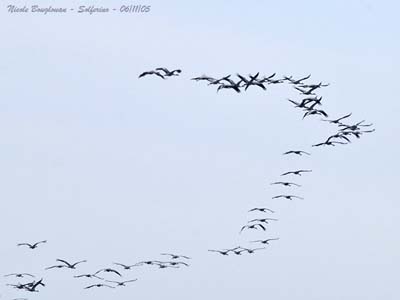
Common Crane
(Grus grus)
Already, towards late October, the undulating flights animate the sky, accompanied by unceasing calls “krou-krou-krou”. The first Common Cranes’ flocks announce the autumnal migration for wintering beneath more clement skies.
Many people see in the cyclic cranes’ migrations a symbol of regeneration. Some attach them to the hyperborean worship, stemming from Greek Mythology. These mythical inhabitants of Northern Europe lived in a country considered as Heaven on Earth. The Common Cranes would be to a certain extent, the messengers of this other universe, “behind the North wind”.

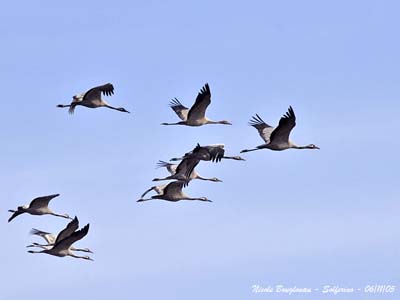
During the migrations, the bird showing the way at the head of the V-shaped flock has in front of him only the unlimited horizon. But the others, in shifted position, also have in front of them the empty space. From time to time, the bird which is in the lead leaves the place to another, and takes again a more modest rank in the flock. The Ancients saw in this game a great sense of responsibility and an obvious democracy symbol.
But the Common Crane is not only a symbol. It is also an improved bird, being able to fly at great elevation and on long distances. It invariably follows the same way, a band of a hundred kilometres of width, which leads it in autumn from northern Europe towards France, Spain and North Africa, and return in spring by the same way. The species breeds in northern Europe, Scandinavia, Denmark, Poland, Russia and Siberia.
Wintering sees the flocks stopping in France (Champagne and Landes of Gascogne), and especially in Spain, in Extremadura. A few thousands of birds go to Morocco. Another way of migration leads the flocks to Tunisia and Algeria, coming from Finland. The populations of Central Asia migrate as far as Ethiopia, via the Nile valley, for wintering.
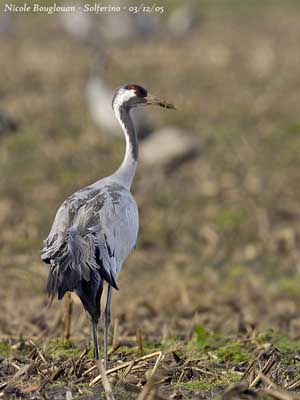
Common Crane is a wonderful bird, walking slowly in an elegant way as soon as it is on the ground. Its slate-grey plumage, enhanced with black or bluish-black on primary and secondary flight feathers, gives to this bird a proud pace. These fairly long feathers fall on the short tail, and “dance” while the bird is moving.
The head shows a red patch of bare skin at the top of the crown. Upper neck, throat, face and nape are black. A white patch coming from the eyes extends downwards to the hind neck. The grey bill shows some reddish at the base. The red eyes give mystery to the glance. The long black legs with three large fingers (the thumb is insignificant) carry this majestic whole with a light step.
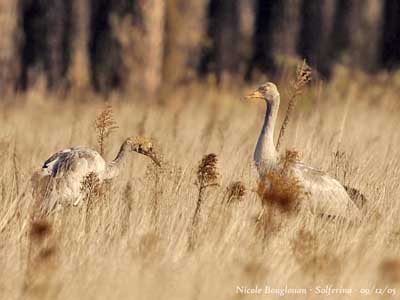
The young are slightly smaller, and their entirely feathered head is mainly chestnut. The greyish throat and the brownish upperparts make the difference, as the less bulky tail. Brown or dark grey legs, grey or brown eyes, they will need several successive moults to reach the beautiful adult plumage, about three to four years. Both sexes are similar.
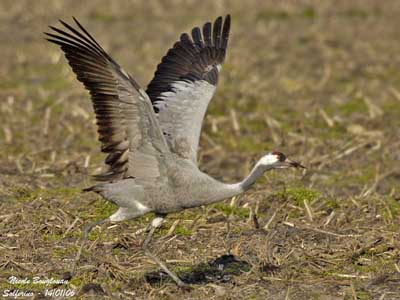
The Common Crane is a shy bird which flees from the least danger by running on a few meters with spread wings before to fly away. It is a noisy bird too! Its voice can be described like a cawing carrying far, uttered on high-pitched and rough tone such as “krouou” and “grououj”, but also “kaerr”. Variations may be heard on the nesting areas, particularly during the spectacular courtship displays.
It starts in February on the wintering areas, but it is at its height in March. The cranes walk with fast and short steps and half-opened wings, making circles, ellipses or eight-shaped ways. They bow deeply and jump in the air this way and that, collecting on the ground any object, and stopping abruptly by adopting a stiff posture. The calls are flying from all sides, the agitation lasts a small moment and quietens down, for better taking up again later. The crane is monogamous and pair bonds last for the life.
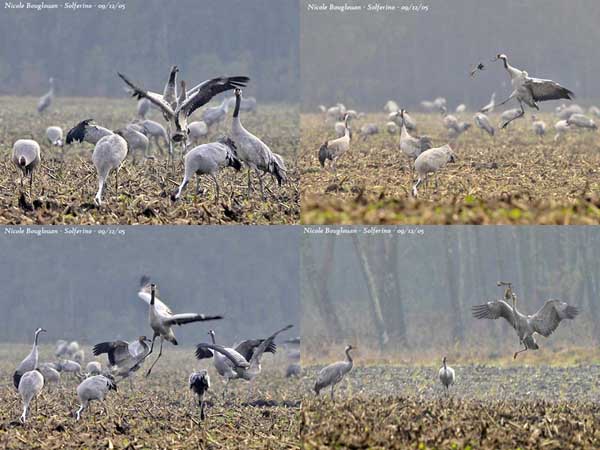
During the breeding season, this so gregarious bird becomes territorial. The pair is solitary nester in wet and wooded areas, or on small island for better protection against predators.
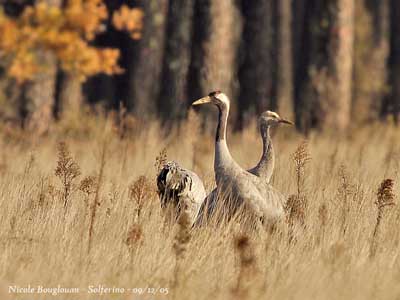
The nest is a large platform made with dry grass on the ground. The female lays one or two eggs, and the incubation lasts four weeks, shared by both parents. The chicks are precocial and follow the adults very soon through the marshes in search of food, including mainly at this moment insects and molluscs, but also small vertebrates.
The young fledge at two months, but they remain with their parents until the winter end. They will reproduce only at three to five years of age.
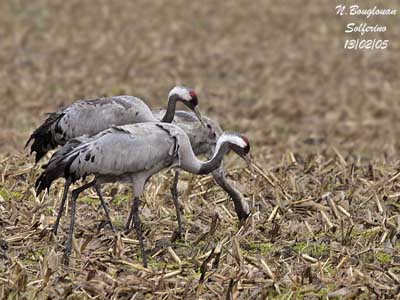
The Common Crane frequents wetlands, oak groves and cultivated and harvested cereals’ fields. It finds there abundant food, including plants, varied kinds of seeds, but especially cereals, roots, and stems of subaquatic plants on the shores of the ponds. Acorns are also part of its diet, especially in November and December. It also feeds on insects, molluscs and small crustaceans. Occasionally, it will capture small birds living on the ground, and small rodents.

The advancing flock is noisy, the calls are heard from very far. The birds fly approximately at about one hundred metres above the ground. They remain on the feeding areas until sunset. The cranes go from a point to another in short flights and always while calling. When they are on the ground, they call in a different way, like an alarm call, two notes, with lower second. Observation of postures similar to those adopted during the courtship displays is common.
The return to the roost uses the same way that in the morning. The cranes which are already on the ground are calling, and those which arrive answer. The place where the first groups land indicates the place where the greatest concentration of birds will occur at night. The birds sleep the head under the wing, but some sentinels are vigilant, ready to give the alert at the least threat.
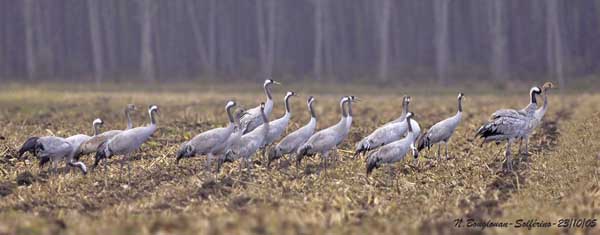
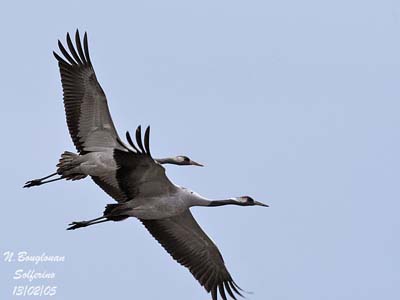
The Common Crane, whose populations appear relatively stable, is however threatened by destruction or alteration of its habitat, particularly on the wintering areas. The deforestation of the oak groves, the poisonings related to the feeding in the cultivated areas where the use of the pesticides is usually important, exploitation, and drainage of the nest-sites, collisions with electric lines, hunting, human disturbances… are as many threats which hang over this species.
Their presence in our Landes of Gascogne where I observe them every year fills me with joy. To hear their calls early in the morning, even before to see them, expecting them, the eyes fixed towards the horizon, and finally to see these large undulating V on blue sky and rising sun background, remain unforgettable moments.
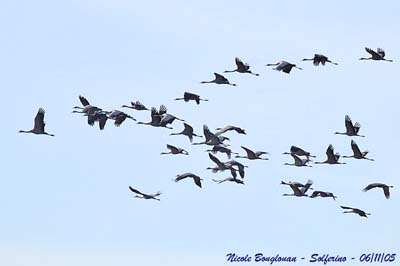
To look at the increasing flight which advances little by little, seeing these large birds slowing down and letting hang their long legs for landing, and finally contemplate this large moving herd on the ground, are the regular scenes of a show in several acts, played many and many times, and renewed each year, for our greater pleasure.
Text and photographs by Nicole Bouglouan
Other link: Common Cranes in Spain - Back to roost
Sources :
Personal observations during the wintering of this species in my region.
THE HANDBOOK OF BIRD IDENTIFICATION FOR EUROPE AND THE WESTERN PALEARCTIC, by Mark Beaman, Steve Madge - C.Helm - ISBN: 0713639601
Pájaros de España (JL Beamonte)
Wikipedia (Wikipedia, The Free Encyclopedia)
What Bird-The ultimate Bird Guide (Mitchell Waite)
Syndicat mixte de gestion des milieux naturels - Site d'Arjuzanx
Informations about migration sites and Common cranes